
At present, the mainstream technology for fixed network access is PON. In the early years, it was mainly used for home/commercial user access by operators. Now it is gradually expanding to large-scale enterprise parks (POL) and even industrial network expansion (F5G). The development momentum is out of control. So what kind of technology is PON technology? What is the network architecture? What is the data transmission method? Let's take a look below. PON technology is a general term for a class of technologies, including the early narrowband PON, APON, BPON, the current popular EPON, GPON, 10G EPON, XG-PON, XGS-PON, and later 50G-PON......
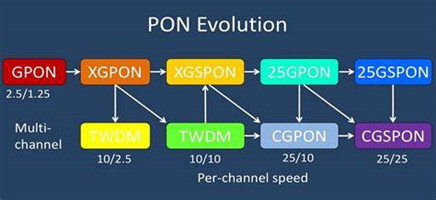
The foundation of all these PON technologies is the same, that is, the PON network architecture and data transmission methods.
PON Network Architecture
Regarding the PON network architecture, we have to bring out this classic networking diagram
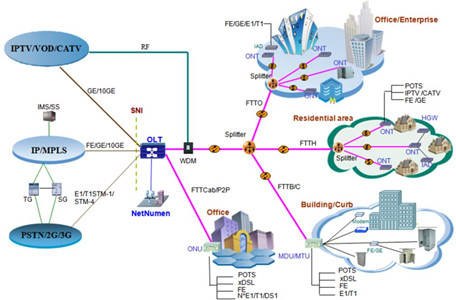
Summary of technical points:
l PON is a passive optical network with a point-to-multipoint (P2MP) structure
l PON is composed of optical line terminal OLT, optical network unit ONU and optical distribution network ODN;
l The reason why PON is called "passive optical network" refers to the passive part of ODN (POS, passive optical splitter, which is a physical optical device and does not require an external power supply)
l PON can use first-level splitting or second-level splitting (in actual engineering, the second-level is mostly)
l The PON access radius (the distance between the OLT and the ONU) is generally planned to be within 20 kilometers (20 kilometers is the physical distance). Among them, urban access is generally 5-10 kilometers, and there may be more than 10 kilometers or even 15 kilometers in remote mountain villages or sparse areas.
PON Network Data Transmission Method
After understanding the PON network architecture, let's analyze how data is transmitted based on this architecture. The data transmission of the general network is based on two-way: both from the sender to the receiver, and from the receiver to the sender, we also call it downlink and uplink.
From the previous PON network architecture, we know that PON is point-to-multipoint.
There is actually only one optical fiber between the OLT and the POS. How to realize the transmission of upstream and downstream data in one optical fiber?
[Answer]: Divide different lanes, that is, plan different wavelengths.
[Analysis]: In the PON network, the wavelengths used for upstream and downstream communications are different. For example, EPON/GPON belong to the 1G PON technology. Their downstream wavelength planning is 1490nm, and the upstream wavelength planning is 1310nm. They do not affect each other. It can fully realize two-way full-duplex communication. In addition, there is also the CATV service of the radio and television, and the separate wavelength is planned to be 1550nm.
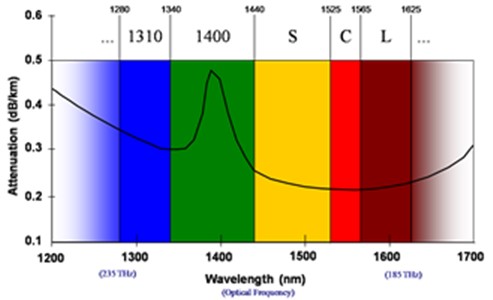
Why do we stipulate that the downstream wavelength is 1490nm and the upstream wavelength is 1310nm, but not the other way around?
[Answer]: Cost considerations.
[Analysis]: At the time the standard was formulated, 1310nm optical devices were relatively mature and low cost, while the cost of 1490nm was relatively high. PON is a point-to-multipoint architecture, so we naturally want to place relatively low-cost devices at the originator of the multipoint side, so that the initial deployment cost of the PON network can be greatly reduced.
we continue to return to the introduction of data transmission on the PON network. The PON downstream uses broadcast to transmit data, and the upstream uses TDMA to transmit data. A series of questions came again:
Why does the PON downstream use broadcast to transmit data?
[Answer]: Because it is simple and practical.
[Analysis]: The downstream direction of the PON refers to the direction from the OLT to the ONU. The relationship between the number of senders and receivers in this direction is a "one-to-many" relationship, so we will naturally choose to use broadcast to send data. Because this is the most trouble-free. At the same time, because the downstream is limited by the physical characteristics of the passive splitter, the data sent from the PON port is evenly distributed to each branch after passing through the passive splitter. Its passive physical characteristics cannot control the communication of a certain branch. Nowhere, only a simple split function can be realized, so the downlink realizes the phenomenon of passive broadcasting based on the physical split characteristics.
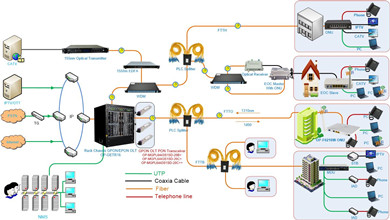
PON downstream uses broadcasting, and each ONU can receive data from other ONUs. How to ensure data security?
[Answer]: ONU actively filters, and data is encrypted.
[Analysis]: On the one hand, the ONU will actively filter its own data according to the corresponding filter conditions, such as filtering and receiving its own data through ONU ID (GEM-PORT ID); on the other hand, the data sent by the OLT to each ONU It will be encrypted (such as GPON's AES-128), and the encrypted key is generated by each ONU and sent to the OLT. The ONU will not know the keys of other ONUs, so it is difficult to decrypt the data belonging to other ONUs.
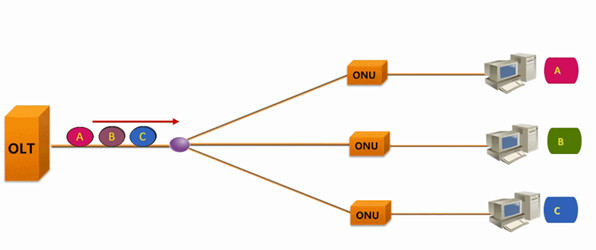
Why does Image PON upstream use TDMA to transmit data?
[Answer]: Realize the simultaneous transmission of data by multiple ONUs and fair competition.
[Analysis]: The upstream direction of the PON is the opposite of the downstream direction, that is, the direction from the ONU to the OLT. The relationship between the number of sending and receiving ends in this direction is "many-to-one". Since it is a "many-to-one" relationship, it is certainly not allowed for each ONU to send data for granted, otherwise there will be superposition of optical signals of the same wavelength (such as GPON 1310nm), and the OLT cannot read the data after receiving it, resulting in errors. The code frame or unknown frame prompts and discards it.
Therefore, in this case, there must be an arbitration mechanism to protect our uplink data transmission from conflicts. This arbitration mechanism is TDMA, which divides the uplink into different time slots, and then allocates these time slots to different ONUs as needed, and the ONU sends data in its own time slot.
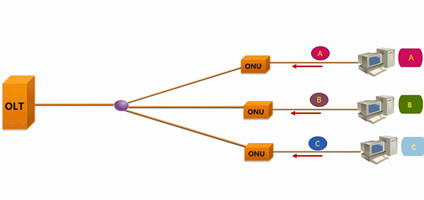
Therefore, we also see here that the ONU's light-emitting time is strictly specified by the OLT, and it will not actively emit light, nor will it emit light for a long time. Once an ONU is actively or for a long time emitting light, this ONU is a "rogue ONU", which will affect the business under the entire PON port

